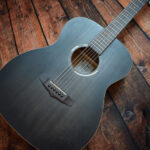Creating realistic electric guitar parts using virtual instruments can be challenging, but with the right techniques, you can achieve remarkably authentic sounds. Many virtual guitar instruments, like RealLPC, offer a range of features to enhance realism, allowing you to move beyond basic MIDI input and capture the nuances of a genuine electric guitar performance.
One key aspect of realism is dynamic expression. For techniques like palm muting, velocity sensitivity is crucial. By assigning a lower velocity value, such as 40, to palm-muted notes, you can automatically trigger a softer, muted tone. Conversely, for percussive “chukka” or “choke” effects, employing a technique like a hidden “choke” trigger in your score to activate a high velocity of 127 can produce the aggressive attack needed for these sounds. This velocity control is fundamental to bringing Virtual Electric Guitar parts to life.
For those seeking the ultimate in realistic performance, a two-phase workflow can be incredibly effective. Begin by sketching out your guitar parts using standard MIDI techniques, focusing on note accuracy and rhythmic precision. This allows you to quickly capture your musical ideas. In the second phase, create a new track and manually re-perform the composed parts, this time utilizing the full expressive capabilities of your virtual electric guitar instrument. By reading your initial composition as a guide, you can incorporate nuanced key switches and performance articulations, injecting a human feel and maximizing the guitar-centric features of tools like RealLPC. This approach marries the accuracy of planned composition with the organic expressiveness of a live guitar performance.
Consider the composition process for a song like “Black Friday.” Virtual electric guitars are invaluable when experimenting with variations, such as riff changes within pre-choruses. By composing these variations using a virtual instrument, you can efficiently evaluate different ideas and make informed decisions before band rehearsals, saving valuable time and streamlining the creative process.
Similarly, for complex harmonic ideas, such as the polychord used in the bridge of “Tripwire” – an Ab major chord over a G major chord – a virtual electric guitar allows for detailed exploration of voicing. The specific voicing of a chord dramatically impacts its character, and the constraints of the physical electric guitar can influence these choices. Using a virtual instrument like RealLPC, you can experiment with different voicings and discover techniques like interlocking voices between two virtual guitar parts, creating a richer and more textured sound where individual voices within the polychord maintain their distinct identities even when interwoven. This exploration highlights how virtual electric guitars are not just tools for sound reproduction, but also powerful instruments for compositional discovery and refinement.

